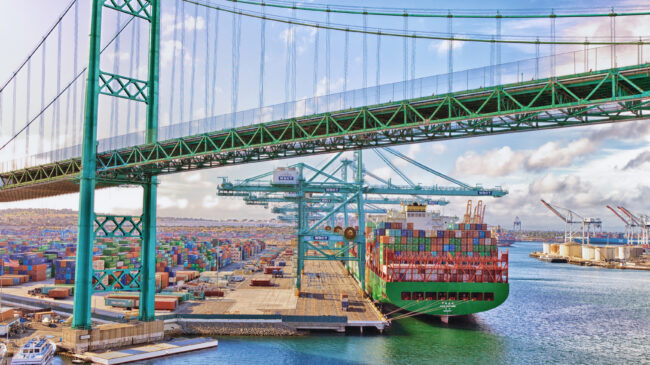Snarled supply chains are a major economic and news story, with dramatic photos of dozens of container ships waiting offshore for weeks at a time for the opportunity to unload their cargoes at overflowing West Coast ports. In a sign of the times, the Ports of Long Beach and Los Angeles became so congested that some ships could not even approach shallower depths to anchor, forcing them to drift 20 miles offshore. But it’s not just the ports; every hub and spoke of the logistics chain is at capacity. And unfortunately for pundits and politicians in Washington, D.C., there are no policy levers to pull to quickly and easily resolve these issues.
To be sure, certain government policies have made this situation worse than it otherwise would be. These policies include the failure to adopt international best practices and technologies at U.S. ports due to intransigent labor unions and their allied politicians, the duties on Chinese truck chassis that have tripled their price in recent years under the Trump and Biden administrations, and unprecedented federal COVID-19 relief, stimulus and unemployment money going to many households, which contributed to spending. However, while policy reforms could help improve the long-run resilience of the supply chain, the main source of these problems is unusual short-run consumer demand that public policy is ill-suited to address.
The COVID-19 pandemic caused a large shift in consumption from services to durable and nondurable goods, while total consumption has remained on-trend thanks, in part, to generous government assistance that kept personal incomes high throughout the pandemic. E-commerce, in particular, saw a massive boom, and the nature of e-commerce plays an outsized role in pushing various logistics segments overcapacity.
Here’s a simplified story that illustrates the cascading impacts of pandemic-induced changes in household consumption:
- The rapid flows demanded of e-commerce—from production to distribution to end consumers—caused warehouses that were already stocked with goods meant for pre-pandemic consumers to become more congested as they attempted to adjust to pandemic-caused increases and changes in goods demand.
- Because there was no space in the warehouses, goods were delayed in unloading from shipping containers on truck chassis in parking lots and loading docks outside the warehouses.
- Because warehouse parking lots and loading docks were overflowing with full containers and truck chassis, rail customers were not picking up their containers and chassis from freight rail ramps.
- Because rail customers weren’t picking up their goods from freight rail ramps, rail carriers could not return empty containers and chassis to seaports.
- Because seaports lacked the chassis to move containers out of ports to inland distribution centers, overflow storage quickly reached capacity at ports.
- And because there was no space in ports to unload containers from massive container ships, container ships waited for days and weeks offshore to unload their cargo.
Every hub and spoke of the logistics chain is strained due to this shift in consumption and spike in good demand. Unfortunately, attempting to address one link, perhaps by moving to 24-hour schedules at ports as supported by President Joe Biden, will not address problems in other parts of the chain and could possibly exacerbate them.
There are two possible ways out of this mess: consumer goods demand wanes to something closer to pre-pandemic trends or logistics capacity is added to support the “new normal” demand. The latter takes time, as firms must build and acquire a lot of additional structures and equipment, as well as hire new people to work them. Expanding capacity to meet a potential “new normal” of goods demand entails large risks to sunk capital investment from making big bets that present consumption patterns will persist, which is why firms may be reluctant to invest in additional capacity that may not be needed if consumers begin shifting from goods back to services as the pandemic wanes. An economic recession could also bring relief to strained supply chains, although this is obviously not preferable.
With the public and businesses feeling the impacts of supply chain problems and news stories already scaring parents that their Christmas toys may not arrive in time for the holidays, politicians are likely going to continue wanting to show they are doing something about the problem by holding summits with business and labor leaders, appointing “czars,” and engaging in other photo opportunities to present the illusion that they can solve these problems. But the reality is supply chain problems are largely out of policymakers’ control and almost certain to continue through 2022. Markets and businesses will adjust but not on a dime.
Despite politicians looking to blame opponents for supply chain issues and assurances from other politicians that they can fix it, there are no quick and painless ways out of this strange supply chain situation, which is largely yet another unpredictable consequence of a rare, 100-year global pandemic. Instead of asking politicians to do something out of their control, consumers must accept these COVID-related supply chain difficulties are here for the time being. For now, policymakers should be vigilant about avoiding well-meaning but counterproductive policy responses and, instead, work to improve long-run supply chain resilience by jettisoning existing harmful government policies.

